|
|
|
|
| prev section | index | next section |
|
|
|
|
| prev section | index | next section |
This section provides a "tool box" of traffic management and traffic calming techniques that are available for consideration and use.
Choose the Right Tools
Any job is made easier by using the right tools. In the
management and calming of traffic,
strategies and solutions are based on two fundamental ideas:
Aesthetics
Aesthetics should be considered in the process of developing
traffic management
solutions. To be successful, traffic management and calming
measures should achieve a
balance between aesthetics and the objective of calming traffic
as no program will succeed
if it is not based on community support. It is the intent of this
program to develop
solutions where safety, speed control and aesthetics are mutually
supportive.
Selection of Tools
Almost all traffic management techniques (tools) have some effect
on both traffic volume
and speed. However, it is evident that some tools used to calm
traffic can have a greater
or lesser effect than others in controlling either volume or
speed. Also, some tools are
more effective and desirable on local neighborhood streets and
less desirable for complex
traffic management applications on collectors, minor arterials,
or emergency response
routes.
Emphasis in this program will be given to the selection of tools which are self-enforcing - that is, those which are physical traffic management measures. These tools are designed to affect driver perception of the street or neighborhood and are designed to directly influence motorist behavior. Unlike traditional methods of traffic management, such as the use of stop signs or speed limit signs, physical traffic calming measures rely on physically modifying driver behavior in a neighborhood.
Diverting Traffic Intentionally to Other Streets
In selecting tools to be used on streets it is important to limit
the potential detrimental
effects of diverting excessive volumes of traffic from one local
street to another, or from
collector or minor arterial streets to local streets. The
potential for the diversion of traffic
is considered in the selection of tools for all neighborhood
traffic management projects.
Since neighborhood collectors, and in particular, minor arterials, are meant to serve as through streets, traffic management projects for these situations are not primarily designed to decrease traffic volumes. Instead, emphasis is on reducing traffic speeds, enhancing pedestrian usage, and associated concerns.
Choosing Other Minor Arterial Streets
For complex traffic management projects, while it is not expected
that the primary result
will be to divert traffic away from the project street, some
decrease in traffic volumes may
occur as a result of the project. For example, some drivers may
prefer not to use the
traffic calmed street after the devices are installed. One
outcome may be that drivers may
choose to use other arterial streets instead. This is an
appropriate use of these arterials
and represents an objective of the program since they are
intended to serve through traffic.
Techniques for Local Street Projects
Speed Control Measures
Speed control measures are of three types: vertical measures,
which use the forces of
vertical acceleration to discourage speeding; horizontal
measures, which use the forces of
lateral acceleration to discourage speeding; and narrowings,
which use a psycho-
perceptive sense of enclosure to discourage speeding. Tables 4,
5, and 6 below
summarize the measures and their effects.
Vertical Measures
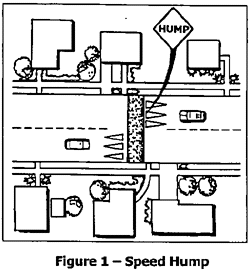 Speed humps are rounded raised areas placed across the road
(Figure 1).The standard speed hump
used in the City of Santa Fe is 14 feet long and 3 inches high.
Its design speed (speed at
which the 85th percentile is estimated to be) is 18 to 23 mph.
Usually these humps are
constructed with a taper on each side to provide for drainage. In
some locations it may
be desirable to provide a space wide enough to accommodate
bicycles but this may also
encourage motorists to cross the hump with one wheel in. the
gutter and the other on the
hump. Speed humps may be located on streets where gutters exist,
but considerations
must be given to pedestrians if sidewalks are not in place. If no
curb and gutter is in
place, then devices such as bollards may be placed on each side
of the humps to
discourage motorists from driving on the shoulders.
Speed humps are rounded raised areas placed across the road
(Figure 1).The standard speed hump
used in the City of Santa Fe is 14 feet long and 3 inches high.
Its design speed (speed at
which the 85th percentile is estimated to be) is 18 to 23 mph.
Usually these humps are
constructed with a taper on each side to provide for drainage. In
some locations it may
be desirable to provide a space wide enough to accommodate
bicycles but this may also
encourage motorists to cross the hump with one wheel in. the
gutter and the other on the
hump. Speed humps may be located on streets where gutters exist,
but considerations
must be given to pedestrians if sidewalks are not in place. If no
curb and gutter is in
place, then devices such as bollards may be placed on each side
of the humps to
discourage motorists from driving on the shoulders.
|
 Speed tables are flat-topped speed humps and can be constructed
with brick or other
textured materials on the flat section (Figure 2).
These devices have the advantage of possibly being
used to provide a pedestrian crossing and can be marked and
placed at intersections or
other pedestrian crossing locations. In this case they are called
raised crosswalks.
These devices are long enough for the entire wheelbase of a
passenger car to rest on the
top. The use of brick or other textured materials improves the
appearance and tends to
draw attention to them and may enhance safety and speed
reductions. The standard
speed table used in the city of Santa Fe is 22 feet long and 3
inches high. Its design
speed is 25 to 30 mph. In effect the device is less jarring than
a speed hump and reduces
higher operating speeds with out affecting the average driver.
There is an alternate
version of this device that may be used to calm traffic at an
entire intersection called a raised intersection (Figure 3).
Speed tables are flat-topped speed humps and can be constructed
with brick or other
textured materials on the flat section (Figure 2).
These devices have the advantage of possibly being
used to provide a pedestrian crossing and can be marked and
placed at intersections or
other pedestrian crossing locations. In this case they are called
raised crosswalks.
These devices are long enough for the entire wheelbase of a
passenger car to rest on the
top. The use of brick or other textured materials improves the
appearance and tends to
draw attention to them and may enhance safety and speed
reductions. The standard
speed table used in the city of Santa Fe is 22 feet long and 3
inches high. Its design
speed is 25 to 30 mph. In effect the device is less jarring than
a speed hump and reduces
higher operating speeds with out affecting the average driver.
There is an alternate
version of this device that may be used to calm traffic at an
entire intersection called a raised intersection (Figure 3).

|
| Traffic Management Device | Speed Reduction | Volume reduction | Noise and Pollution | Emergency Vehicle Access | Maintenance | Access Restrictions | Safety |
|---|---|---|---|---|---|---|---|
| Speed Humps | Yes | Traffic diversion possible | Increase | Some problems | Street cleaning difficult | None | Unclear |
| Speed Tables | Yes | Possible | Some Increase | Acceptable | Street cleaning difficult | None | Improved Ped Safety |
| Raised Intersection | Yes | Possible | Small Increase | Acceptable | Street cleaning difficult | None | Improved Ped Safety |
Horizontal Measures
Horizontal measures achieve speed reduction by forcing drivers to
drive around a device or
to change direction, and by visually blocking long views of the
road ahead.
Traffic circles are raised islands located at intersections around which traffic circulates (Figure 4). They are usually, though not always, circular in shape. A circle prevents drivers from speeding through an intersection by eliminating the straight through movement and forcing drivers to slow down to yield. Drivers must first turn to the right, then to the left as they pass the circle, and then back to the right again after clearing the circle. Large trucks can be accommodated by design modifications to the circle. Traffic circles are very effective in controlling vehicle speeds at an intersection - generally the design speed is 15 to 20 mph for passenger cars. At mid-block locations vehicles can speed up. The safety record is excellent as they generally reduce intersection-related accidents by up to 90 percent.
Chicanes are curb extensions that alternate from one side of the street to the other, forming S-shaped curves (Figures 5 and 6). They can prevent speeding by causing a change in direction of drivers and are speed control devices that are used in mid-block areas.
Lateral Shifts are curb extensions on otherwise straight streets that cause travel lanes to bend one way and then back to the other way to the original direction of travel (Figure 7). These devices can be used in conjunction with the creation of parking areas on streets. The design speed of this device is based on how much the street is bent and reductions in speeds can be quite significant.

| 
|
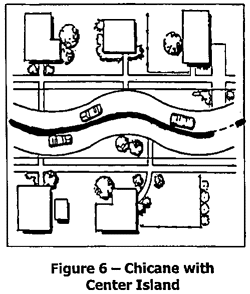
| 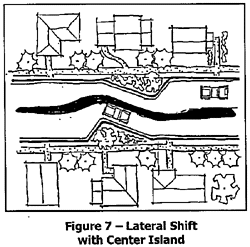
|
| Traffic Management Device | Speed Reduction | Volume Reduction | Noise and Pollution | Emergency Vehicle Access | Maintenance | Access Restrictions | Safety |
|---|---|---|---|---|---|---|---|
| Traffic Circles | Yes, within Intersection | Possible | Some increase | Some Limitations | Vandalism | None | Improved |
| Chicanes | Possible | Possible | Possible pollution increase | Possible problems | None | None | Possible improvement |
| Chicanes w/center Island | Yes | Possible | Possible pollution increase | Possible problems | None | None | Possible improvement |
| Lateral Shifts w/center Islands | Yes | Possible | Small increase | Possible problems | None | None | Possible improvement |
Narrowings
Narrowing is usually accomplished by placing vertical elements in
the roadway, and is
intended to draw attention to a constriction in the road and to
have a visual affect on
drivers. For example, the roadway could be narrowed, and
plantings or street furniture
could be placed in the right-of-way. Neckdowns (bulbouts) are
curb extensions at
intersections that reduce the roadway width (Figure 8). If coupled with
crosswalks they are called
safe crosses. The main objective of this device is to
"pedestrian-ize" intersections by
shortening the crossing distance and to reduce the speed of
turning vehicles.

| 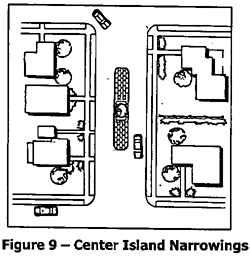
|
Center island narrowings are raised islands located in the center of a street that narrow the travel lanes at that location. They can be attractively landscaped and are successful in providing a visual amenity and a neighborhood identity. If used at the entrance to a neighborhood and supplemented with textured pavement and monument signs they are called gateways (Figure 10). Centered islands have been effectively used on curves where speeding is a concern. They eliminate the possibility of drivers swinging wide to speed though curves. Uke other narrowings, these devices can help to pedestrainize streets as they provide a refuge area for pedestrians~in the center of the street.
Chokers are curb extensions at mid-block that narrow a street by widening the sidewalk or planting strip (Figures 11 and 12). Chokers should generally be placed to provide a minimum of two traffic lanes, since if only one lane is provided opposing traffic will compete for space or right of way.

| 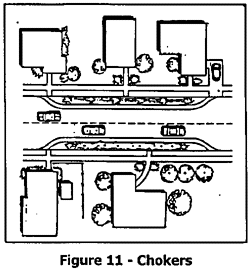
|

| |
| Traffic Management Device | Speed Reduction | Volume Reduction | Noise and Pollution | Emergency Vehicle Access | Maintenance | Access Restrictions | Safety |
|---|---|---|---|---|---|---|---|
| Bulbouts | Yes, turning speeds reduced | No effect | No effect | Some limitation | None | None | Improved Ped Safety |
| Center Island Narrowings | Yes, possible on curves or turns | Not likely | No effect | Some limitation | None | None | Improved Ped Safety |
| Gateways | Possible | Mixed Results | No effect | Possible problems | None | None | Possible Improvement |
| Chokers | Possible, minor | Possible | No effect | No effect | Trucks hit curbs | None | Improved Ped Safety |
Volume Control Measures
Table 7, entitled Traffic Calming Tools of Local Street Projects,
summarizes the measures and their effects.
Full street closures are barriers placed across a street to close the street completely to through traffic, usually leaving sidewalks or bicycle paths open (Figures 13 and 14). The barriers may consist of landscaped islands, walls, side-by-side bollards, or any other obstructions that leave an opening smaller than the width of a passenger car. These devices are a possible solution for cut-through traffic but are very controversial. The main concerns are the effect of the closures on emergency response, street network connectivity and that parallel streets may receive diverted traffic. This device is considered as a last resort if all other devices have failed.
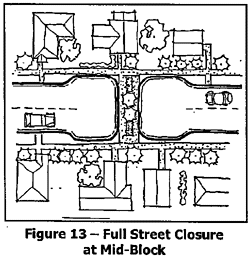
| 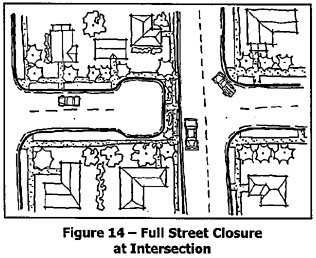
|
Diagonal divertors are barriers placed diagonally across an intersection, blocking through movement. These are designed to create circuitous routes through neighborhoods. As with the full street closure, there are concerns with the effect of the closures on emergency response, street network connectivity and traffic diversion.
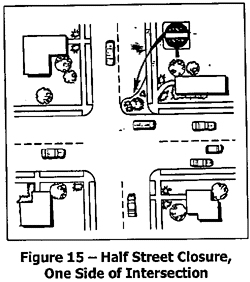
| 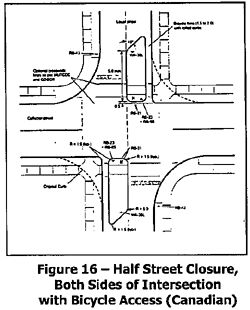
|
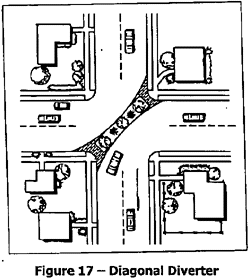
| 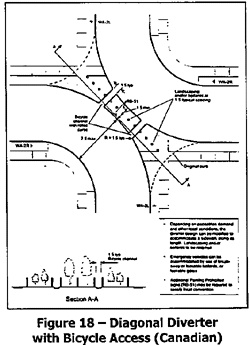
|
Median barriers are raised islands located in the center of a street and continuing through an intersection so as to block through movements and left-hand turns at a cross street (Figures 19 and 20). Forced turn islands are raised islands that block certain movements on approaches to an intersection (Figure 21).
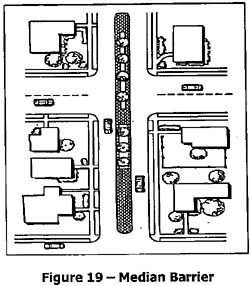
| 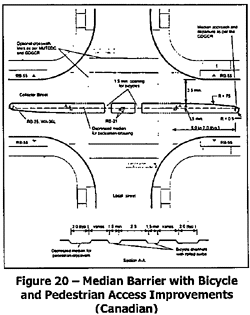
|
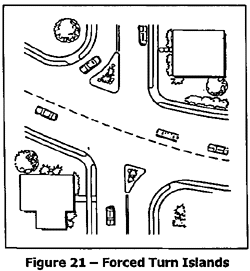
|
| Traffic Management Device | Speed Reduction | Volume Reduction | Noise and Pollution | Emergency Vehicle Access | Maintenance | Access Restrictions | Safety |
|---|---|---|---|---|---|---|---|
| Full Street Closures | Possible | Yes | Decrease | Possible problems | Possible problems, vandalism | All non-local traffic diverted to other streets | Possible, may shift accidents |
| Half Street Closures | Possible | Yes | Small increase | No effect | None | One direction, left/ right turn only | Improved ped safety, may shift accidents |
| Diagonal Diverters | Likely | Yes | Decrease | Possible problems | Vandalism | Through traffic eliminated | Possible improvement |
| Median Barriers | None | Yes | Decrease | Minor limitation | None | Right turns only | Improved |
| Forced Turn Islands | Possibly | Yes | Decrease | Possible limitation | Vandalism | Right turns only | Improved |
Techniques for Complex Traffic Management Projects
The traffic management tools described for Local Street Projects were, for the most part, intended for local neighborhood streets that have primarily residential frontage and that are not designated as Emergency Response Routes. This section addresses all other streets that might be eligible for consideration as a Neighborhood Traffic Management Project. This includes projects that might deal with complex traffic management issues, such as treatment of a system of streets, emergency response routes, areas with complex access and pedestrian issues, or instances where significant diversion of traffic may occur.
Neighborhood collectors are intended to distribute traffic between more principal streets and local streets in the neighborhood. In other words, they are commonly called "through streets" - at least for a limited distance of generally at least V2 mile to no more than 1 mile in length. The streets may also serve multiple purposes, including carrying emergency response routes, buses, bicycles, and possibly trucks.
Minor arterials are meant to serve as through streets, and to interconnect with and augment the principal arterial system. Trips on these streets may be longer in nature than collectors, but are shorter than what should normally be carried on principal arterials.
Whether by design or as a result of growth, minor arterials and some collectors may carry a large number of vehicles through residential areas. When this occurs, the result can be a call by residents for traffic management or traffic calming to restore or improve their quality of life and mitigate the effects of unreasonable through traffic. These situations are more difficult to resolve and are typically controversial in nature.
Traffic calming of residential collectors and minor arterials has been relatively common In Europe for over a decade, but not very common in the United States. The tools discussed in this section are primarily drawn from European experiences and are based on the goal of enhancing the livability of neighborhoods with the primary objective of promoting pleasant conditions for users of neighborhoods, especially pedestrians. As indicated above, collectors and minor arterials do serve a function of carrying varying amounts of traffic. Based again on the European experience, the NTMP program objective of reducing the average speeds of traffic on neighborhood streets will be of major importance.
As indicated above, devices selected cannot intentionally divert
traffic away from project
streets into inappropriate areas. For example, a complex street
project should not divert
traffic on to an adjacent local neighborhood street, placing an
unacceptable burden on
that street. For complex traffic management projects, while it is
not the expected that the
primary result will be to intentionally divert traffic away from
the project street, some
decrease in traffic volumes will likely occur as a result of the
project. For example, some
drivers may prefer not to use the traffic calmed street after the
devices are installed since
higher speeds will not be possible.
Selection of Appropriate Measures
Selection of traffic calming measures for complex street projects
will be based on the type
of street and its functional class. As indicated above, the
consideration of functional class
in selecting measures attempts to strike a balance between
mobility and other objectives
such as compatibility with land use, and pedestrian/bicycle
friendliness. For sub collector
streets, mobility (the design speed of the street) may not be as
crucial as other objectives.
For minor arterials, with multiple lanes in each direction, the
reverse is true. For streets,
which are designated emergency response routes and transit
routes, providing for mobility
is a concern and needs to be addressed.
General Considerations
The NTMP program objective of reducing the average speeds of
traffic on neighborhood
streets will also be of major importance on collectors or minor
arterials treated as a
complex project. The primary measure used to determine the type
of control and the
spacing of devices will be the selection of an appropriate design
speed. Table 8, entitled
Santa Fe Speed/Priority of Classification of Roads for Traffic
Calming, illustrates the design
speed concept. For purposes of traffic calming, the design speed
should be the same as
the posted speed limit as this is what is appropriate based on
the conditions of the street
and environment.
| Class | Type of Classification | Design Speed |
|---|---|---|
| Mixed Priority - Priority is shared between living and traffic functions | collector | 25 mph |
| Minor Arterial | 25 mph | |
| Traffic Street - Major access and through routes, traffic function takes priority but vulnerable road users must be protected | collector | 30 mph |
| Minor Arterial | 30 mph |
Selection of Measures and Spacing
Once the design speed and the class of road are selected, traffic
calming measures
(sometimes called slow points) and the spacing of devices can be
selected. Table 9 shows
guidelines for the spacing of slow points.
| Desired Speed (mph) | Distance between Slow Points |
|---|---|
| 30 | 450 |
| 25 | 300 |
| 20 | 225 |
Examples of traffic calming measures are shown below. The measures used are primarily related to four categories of tools which are: pre-warnings, lateral shifts (discussed in the section for Local Street Projects), speed tables which can also be at intersections in the form of raised intersections (discussed in the section for Local Street Projects), and a technique called "reallocation of right of way".
Pre-warning techniques include the use of gateways, traffic circles at intersections, and the use of appropriate street edge treatments. Table 10, entitled Traffic Calming Tools of Complex Street Projects, Pre-Warning Devices, summarizes the measures and under what circumstances they should be utilized.
| Traffic Management Device | Street Classification | Design Speed | |
|---|---|---|---|
| 25 mph | 30 mph | ||
| Gateways | Collector Minor Arterial | Yes | Yes |
| Traffic circles | Collector Minor Arterial | Yes | No |
| Street Edge Treatments | Collector Minor Arterial | Yes | Yes |
| Roundabouts | Minor Arterial | No | Yes |
Gateways are devices that are used to signal to drivers that there is change in the environment ahead (both neighborhood and road). This can take the form of many things, including structures mounted in center islands, plantings, or a treatment that is distinctive but is safely placed. Again, pre-warnings have proven to be successful in providing warning for traffic calmed areas and have been shown to affect driver behavior as they proceed into the neighborhood.
Roundabouts (Figure 22) and traffic circles can serve as
gateways or be placed intermittently at
intersections as speed control measures. With landscaped center
islands, they can introduce
a change from a business area to neighborhood and serve as both
physical and
psychological dividers.

Table 11, entitled Traffic Calming Tools of Complex Street Projects, Speed Tables and Lateral Shifts, summarizes these measures and when they should be utilized.
| Traffic Management Device | Street Classification | Design Speed | |
|---|---|---|---|
| 25 mph | 30 mph | ||
| Speed Table | Collector Minor Arterial (x) | Yes | Yes (x) |
| Raised Intersection | Collector Minor Arterial (x) | Yes | Yes (x) |
| Chicane | Collector Minor Arterial | Yes | Yes |
| Chicane w/center Island | Collector Minor Arterial | Yes | Yes |
| Lateral Shifts w/center Island | Collector | Yes | Yes |
| Chokers | Collector Minor Arterial (x) | Yes (x) | No |
Reallocation of Right-of-Way
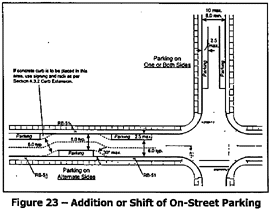 The technique of reallocation of right-of-way achieves speed
control by redistributing
space within the roadway right of way by giving motor vehicles
lower priority and
alternative modes a more equal or increased priority. Typically,
this can include the
reduction of pavement width to provide for easier pedestrian
access at intersections or for
a more pedestrian oriented street, the addition of bike lanes,
the reduction of travel lane
width, the addition of on-street parking, or the deflection of
the roadway by a change in
direction with possibly the addition of center islands. In the
process of reallocation, one
objective is to change the character of a road in ways that
attempt to cause the motorist
to drive more slowly and with greater alertness to potential
conflicts. Sometimes, the
effects or changes are as much psychological as physical because
the motorists perceive
that the road is no longer exclusively motor vehicle oriented.
Table 12, entitled Traffic
Calming Tools of Complex Street Projects, Reallocation of Right
of Way, summarizes these
measures and under what circumstances they should be utilized.
The technique of reallocation of right-of-way achieves speed
control by redistributing
space within the roadway right of way by giving motor vehicles
lower priority and
alternative modes a more equal or increased priority. Typically,
this can include the
reduction of pavement width to provide for easier pedestrian
access at intersections or for
a more pedestrian oriented street, the addition of bike lanes,
the reduction of travel lane
width, the addition of on-street parking, or the deflection of
the roadway by a change in
direction with possibly the addition of center islands. In the
process of reallocation, one
objective is to change the character of a road in ways that
attempt to cause the motorist
to drive more slowly and with greater alertness to potential
conflicts. Sometimes, the
effects or changes are as much psychological as physical because
the motorists perceive
that the road is no longer exclusively motor vehicle oriented.
Table 12, entitled Traffic
Calming Tools of Complex Street Projects, Reallocation of Right
of Way, summarizes these
measures and under what circumstances they should be utilized.
Street edge treatments can be particularly important in higher classification streets such as minor arterials, where other treatments might not be appropriate. These treatments are intended to provide a safe and pleasant environment for pedestrians and can provide a calmer environment for drivers. This includes the use of trees, which change the character of a street, reduce noise, provide shade, and reduce the optical width of a street.
In some cases, the techniques described above can be combined in
traffic calming plans.
Physically and as well as psychologically, this combination can
result in improved driver
behavior.
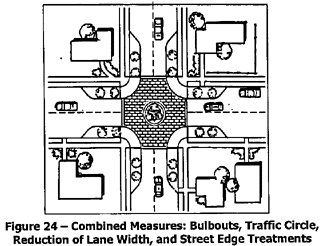
| Traffic Management Device | Street Classification | Design Speed | |
|---|---|---|---|
| 25 mph | 30 mph | ||
| Bulbouts | Collector Minor Arterial | Yes | Yes |
| Center Island Narrowings | Collector Minor Arterial | Yes | Yes |
| Bike Lanes | Collector Minor Arterial | Yes | Yes |
| Reduction Lane Width | Collector Minor Arterial | Yes | Yes |
| Addition of Parking | Collector Minor Arterial | Yes (x) | Yes |
| Street Edge Treatments | Collector Minor Arterial | Yes | Yes |
|
|
|
|
| prev section | index | next section |